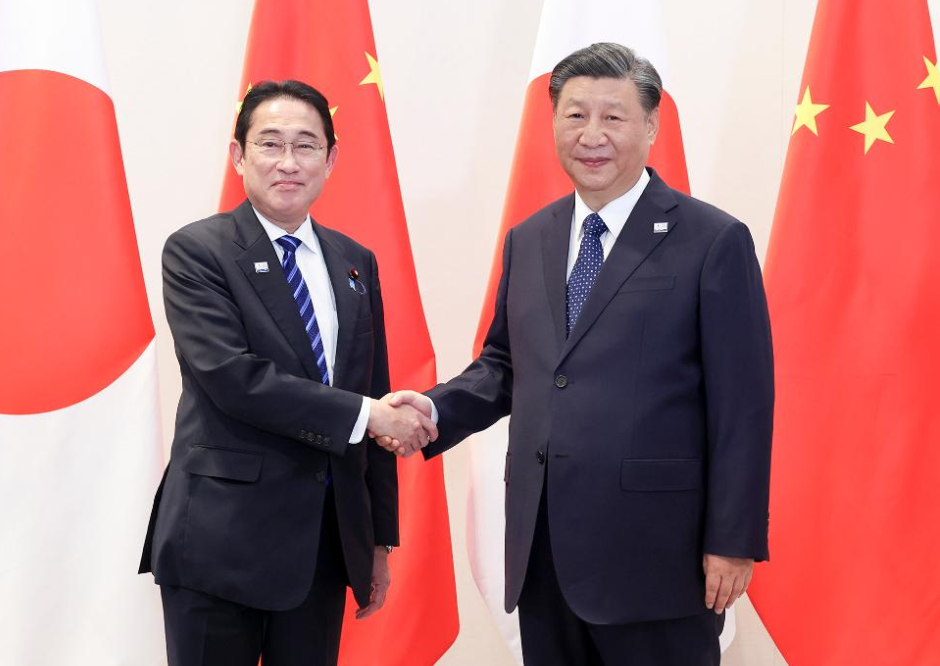
Chinese President Xi Jinping meets with Japanese Prime Minister Fumio Kishida in San Francisco, the United States, Nov. 16, 2023. (Xinhua/Wang Ye)
President Xi Jinping met separately with U.S. President Joe Biden and Japanese Prime Minister Fumio Kaishida during the APEC summit in San Francisco. The meetings were the first between these leaders in the past year and were clearly important for stabilizing China-U.S. and China-Japan relations. Meanwhile, there have been worries that each of these relationships could drift apart again, or even worsen.
For China, relations with the United States are the most important bilaterally, while those with Japan are among the most important in its geographical neighborhood. The U.S. and Japan are military allies, so how to build and maintain a relatively balanced China-U.S.-Japan trilateral relationship is therefore of great significance.
China-U.S. relations have a precious short window of time for stabilization and improvement from now until the U.S. presidential election next year. The ruling Liberal Democratic Party in Japan will also hold its presidential election next fall. Although various challenges and difficulties facing China-U.S. and China-Japan relations will continue to exist, and factors of uncertainty, instability and even deterioration have yet to disappear, it is not impossible to keep the two sets of bilateral ties on track so long as the parties work to create a favorable environment and desirable momentum. The strategic thinking of “momentum formulation” will not only mobilize the endogenous positive dynamism within China-U.S. and China-Japan relations but will even activate the external dynamism at the regional and global levels to promote their healthy development and confine the fermentation of negative dynamism that may drive relations astray.
Momentum has to begin with economics and trade, so activating negotiations on a China-U.S. investment agreement may provide a fine environment for truly preventing economic decoupling. Restarting high-level economic dialogue between China and Japan will help avoid abusive emphasis on security concerns. Trade has served as ballast that stabilizes China-U.S. and China-Japan relations, yet economic interdependence seems to have been considered a security risk in both the U.S. and Japan. Rebuilding perceptions of ballast reactivating negotiations on a China-U.S. investment agreement — which was initiated during the presidency of Barack Obama — will provide external pressure and motivation for both countries to reform their domestic economic structures. China-Japan high-level economic dialogue will be conducive to bilateral discussions on the RCEP, CPTPP and WTO.
Second, waves of a new round of Asia-Pacific economic integration have arrived. Momentum formulation at the regional level is offering a favorable external environment for balanced and healthy China-U.S. and China-Japan relations. East Asian regional cooperation, which began at the end of the last century and reached a high in the first decade of this century with the establishment of the East Asian summit mechanism, has since decelerated as it has become bogged down in turbulence.
If the most outstanding, or climactic, characteristic of the first round of regional integration was China’s rise. The coming second round would represent the collective rise of developing nations in the region. Infrastructure interconnectivity is a rigid demand of regional countries, which is obvious in such flagship projects as the Jakarta-Bandung High-Speed Railway and China-Laos Railway.
As President Xi said in his APEC speech, China is committed to “building an open, vigorous, resilient and peaceful Asia-Pacific community” — which is also a universal wish of countries in the area. The more we proceed toward Asia-Pacific integration, the more constraints will be placed on deteriorating China-U.S. and China-Japan relations.
The U.S. and Japan are in a military alliance for which military deterrence is necessary, yet overemphasis on deterrence could result in escalating tensions, and in turn lead to decreased security. The basic peace and prosperity in the post-Cold War Asia-Pacific does not depend upon military alliances but on an outlook of cooperative security based on dialogue and centered on ASEAN. The Global Security Initiative proposed by China promises both the inheritance of a successful East Asian experience and its further advancement.
Third, the Global South’s collective rise is an important feature of the centenary changes in the world. The more successful China’s Global South diplomacy is, the more its global momentum formulation will help create a macro environment conducive to stable and healthy China-U.S. and China-Japan relations. In March, China successfully maneuvered to foster the normalization of diplomatic ties between Saudi Arabia and Iran. Last year the Chinese president participated in the China-Arab States Summit, and the Chinese presence in the Middle East is gradually increasing.
All these have delivered quite a shock to the U.S., which has maintained great influences in the Middle East, as well as to Japan, which has been in close contact with Middle Eastern nations. But criticizing China for intervening in the Middle East for reasons of geopolitical influence finds little resonance in those countries because their pursuit of modernization calls for a peaceful environment — and so China’s benign intervention is welcome.
BRICS has expanded for the first time since its establishment, growing from five to 11 members, covering Middle Eastern, African and Latin American nations. Some Westerners have labeled BRICS an anti-U.S. club because they fail to appreciate the changes in the great awakening of developing countries’ international political awareness. The Belt and Road Initiative has been embraced warmly by developing nations, while the “debt trap” rhetoric of the West is unsustainable. How could it be sustainable with virtually all Global South countries praising China and only a few Western voices badmouthing it?
So long as the parties take advantage of the post-summit window of opportunity, they certainly can do a lot by way of momentum formulation.
